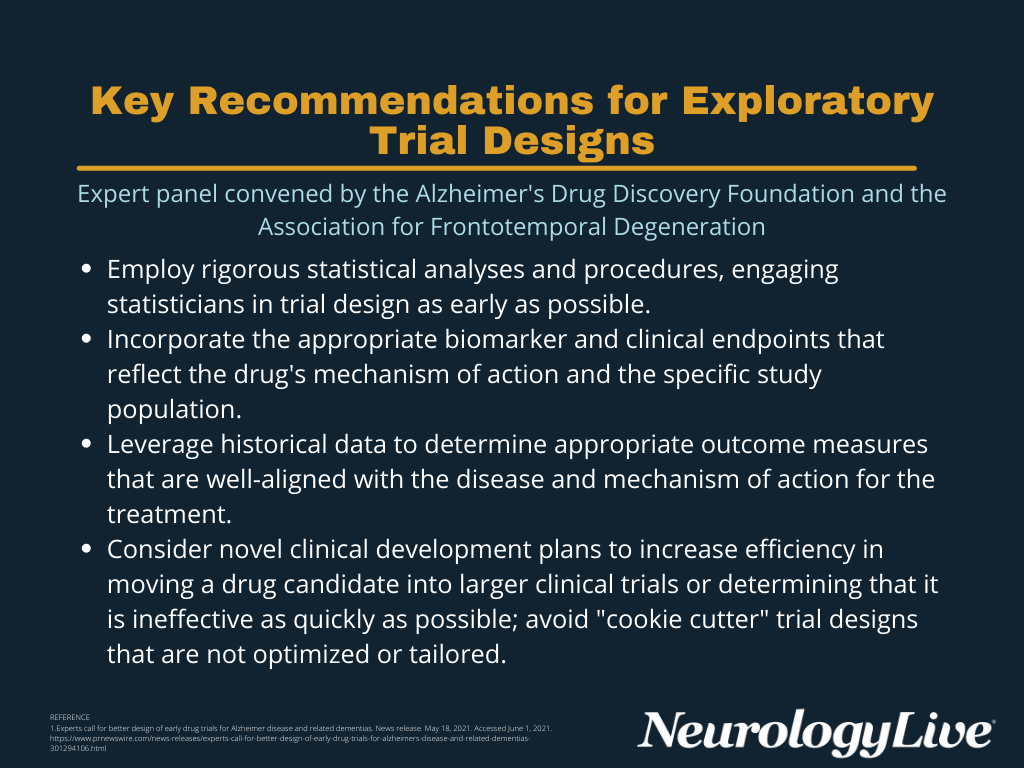Article
Paper Calls for Improved Trial Design for Alzheimer Disease, Dementia-Related Studies
Author(s):
Recommendations for exploratory trial designs may help clinicians be more confident in making the all-important go/no-go decisions about advancing drugs to larger later-stage trials.
Howard Fillit, MD

An advisory panel of experts convened by the Alzheimer’s Drug Discovery Foundation (ADDF) and the Association for Frontotemporal Degeneration (AFTD) recently published a paper providing recommendations on outcome measures and statistical considerations for the design of early drug trials for Alzheimer disease (AD), frontotemporal degeneration (FTD), and other neurodegenerative dementias.1,2
Comprised of statisticians from academia, biotech and pharmaceutical companies, as well as ADDF and AFTD scientific staff, the panel focused on early phase 1 and 2 exploratory studies in effort to help to achieve proof-of-concept more rapidly and lower costs at this level. They provided 4 key recommendations to help advance drugs to larger later-stage trials (FIGURE).
Among them included employing rigorous statistical analyses and procedures, incorporating the appropriate biomarker and clinical end points to reflect the drug’s mechanism of action in the specific study population, leveraging historical data to determine appropriate outcome measures, and considering novel clinical development plans to increase efficiency in moving a drug candidate or determining that it is ineffective as quickly as possible.

"The majority of clinical development costs come from later stage phase 2b and phase 3 studies, which require long treatment periods and a large number of patients to detect meaningful changes in cognitive, behavioral, and functional endpoints," Howard Fillit, MD, founding executive director and chief science officer, ADDF, said in a statement.1 “Results from exploratory phase 2a trials are the critical inflection point when researchers decide which drugs to move into these larger and more expensive trials, so clearly these phase 2a trials need to be as rigorous and well-designed as possible.”
Study Design and Statistical Considerations
Well-defined go/no-go criteria with prespecified analysis is necessary to advance from exploratory studies to later-stage development, according to the paper’s authors. This included analysis of the primary biomarker outcome, as well as analyses assessing the relationship between biomarker response and the response in the expected primary clinical end point that may be used in a subsequent phase 2b or phase 3 confirmatory studies.
The authors also noted that exhaustive exploratory analyses of the data should not be misused to improve the chance of a positive outcome. Investigators also should remain wary and skeptical of proceeding with a drug based on a significant positive effect on nonprimary outcomes.
Outcome Measures
Consideration of the candidate therapy’s mechanism of action, the availability of biomarkers and established clinical assessments to measure activity, and the rate of change for end points are all necessary in selecting the appropriate outcome measures. Although showing clinical efficacy may not be the main goal of an exploratory trial, the potential effects on cognitive and neuropsychological end points may be informative as exploratory outcomes.
The panel also noted that the selection of clinical end points should align with the therapeutic profile for the intervention, which may include scales that reflect the appropriate domain for the clinical syndrome, stage of the disease, and proposed mechanism of action of the test agent. Clinicians should also tailor the duration of exploratory trials based on the expected rate of change for the primary study end points and the mechanism for the study drug.
Patient Population
Enrichment strategies by stage of severity, neuropathology, known genetics, clinical subtype, or other variables may be considered for selecting the appropriate study population. In turn, this may reduce variability and increase the chances of detecting a positive signal related to the mechanism of action. Amyloid positron emission tomography (PET) or cerebrospinal fluid (CSF) amyloid-ß and tau have been used increasingly to confirm biomarkers in patients with AD and may continue to provide a means of biological staging of AD, as well as identifying disease-related outcomes for trials.
Efficacy in Clinical Development
Efficacy is essential in the advancement of a drug candidate and can be demonstrated in multiple different trial designs. A parallel trial approach can build a rich data set by resolving key questions about the drug, whereas basket trials assess a single therapy in different diseases or disease subtypes that share a common clinical or biological endophenotype. Platform trials, which involve multiple drugs tested in a single disease population, benefit from shared infrastructure and shared placebo arms, which can increase statistical efficiency in terms of reduced sample size and power gains.
"These four recommendations can lead to more efficient trials, with substantial financial savings, as well as more strategic and effective engagement of patients," Susan L-J Dickinson, MSGC, chief executive officer, AFTD, said in a statement.1 "The latter is a key concern for a rare disease like FTD where the low number of patients pushes the need for strategic study design, with patients enrolled only in studies that will provide a clear and accurate readout of therapeutic efficacy.”




